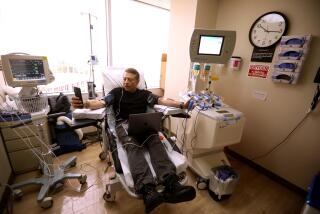Focusing on a Fountain of Youth for the On-Air Talent : Television: A video camera in use at more than 30 stations will electronically breathe new life into the careers of aging news anchors, according to inventors.
- Share via
Imagine looking five, 10, maybe even 15 years younger without having to use messy creams, painful collagen injections, plastic surgery or even makeup.
That day is here.
The only problem: It only works when you appear on TV.
An Emmy Award-winning video camera currently in use at more than 30 stations across the country will electronically breathe new life into the careers of many aging news anchors, according to those responsible for inventing it.
“One anchor in her 50s at a TV station in the Midwest was so amazed at the transformation that now she won’t go on the air without it,” said Greg Pine, marketing manager of Broadcast Television Systems, one of the largest manufacturers of professional broadcasting equipment.
While age and experience give an anchor a desired credibility with his or her audience, viewers do not want to see their trusted news person grow old, Pine said. From the perspective of his customers, he added, ratings and revenue can be affected by such perceptions. And with the images on TV screens getting larger and sharper, viewers are able to see more clearly each wrinkle, spot and blemish on a news anchor’s face.
In the past, stations have used filters, fine mesh nets behind the camera lens, even Vaseline to soften the harsh effects of video on their news personalities. But though such gimmicks can make a person look somewhat better, they also fuzz up the news set.
The computer technology in the “fountain-of-youth camera,” on the other hand, adjusts the skin tone and smoothes out the look of just the faces, while leaving the background and the set unchanged. Lines and wrinkles on the forehead and around the eyes and mouth are diminished, dark or blotchy spots and patches blend evenly into the rest of the face, even a man’s 5-o’clock shadow becomes an unnoticeable 1-o’clock shadow.
Wayne Kube, engineering manager at WFAA-TV, an ABC affiliate in Dallas that replaced 11-year-old studio cameras with six of the BTS models about a year ago, said that the cameras are so much better that viewers and staffers have commented mostly on how much better the whole picture looks. But he confirmed that wrinkles on the faces of the anchor people are lessened when they appear on camera--and anything a station “can do to make a newscast look better will certainly help ratings.”
“And the anchors do like it,” Kube said. “Before, they were prone to comment about how old they looked on video, and that really bothered them. Now they aren’t complaining anymore.”
BTS didn’t invent the technology. RCA was developing a similar system 10 years ago, but the company left the television equipment business in 1985 before getting it on the market. Ikegami Electronics, one of BTS’ major competitors, actually beat BTS by about a year with a camera that makes people appear more youthful. That camera is part of the reason Dan Rather looks better on the “CBS Evening News” set than he does when out in the field or when anchoring “48 Hours,” which is shot on a different set with a different camera.
But the Ikegami camera works on only one person at a time and it must be operated manually. The BTS camera, which sells for about $100,000, can simultaneously adjust the appearance of two people--two anchors sitting side-by-side, for example--and it works automatically at the push of a button (or manually, for finer shading and contouring).
Last month, the Academy of Television Arts & Sciences awarded a technical Emmy to both BTS and Ikegami for this camera technology.
No station in Los Angeles has purchased the camera, but Pine said he is in negotiations with a couple of them. So if your favorite elder statesman suddenly starts to look less like your grandfather, you’ll know why--although generally the hues and contours of the anchor person’s face are adjusted gradually over a month or two so that the change comes about subtly and almost imperceptibly, sort of like Grecian Formula.
It’s obviously not as extreme as Max Headroom--the fictional, computer-generated TV newsman. But it is, in a sense, altering reality in a place where truth, not artifice, is supposed to be paramount.
BTS executives argue that cameras have nothing to do with editorial decisions.
“If this is artifice, then so is using makeup, or lighting the set in a certain way, or a director using a longer shot on somebody rather than getting in for a close-up,” said Skip Ferderber, a BTS spokesman. “It’s not faking anything. Making people look better is simply a part of the art of production.”
KFAA’s Kube agreed. “It’s really nothing more than a really good makeup job,” he said.
More to Read
The biggest entertainment stories
Get our big stories about Hollywood, film, television, music, arts, culture and more right in your inbox as soon as they publish.
You may occasionally receive promotional content from the Los Angeles Times.










